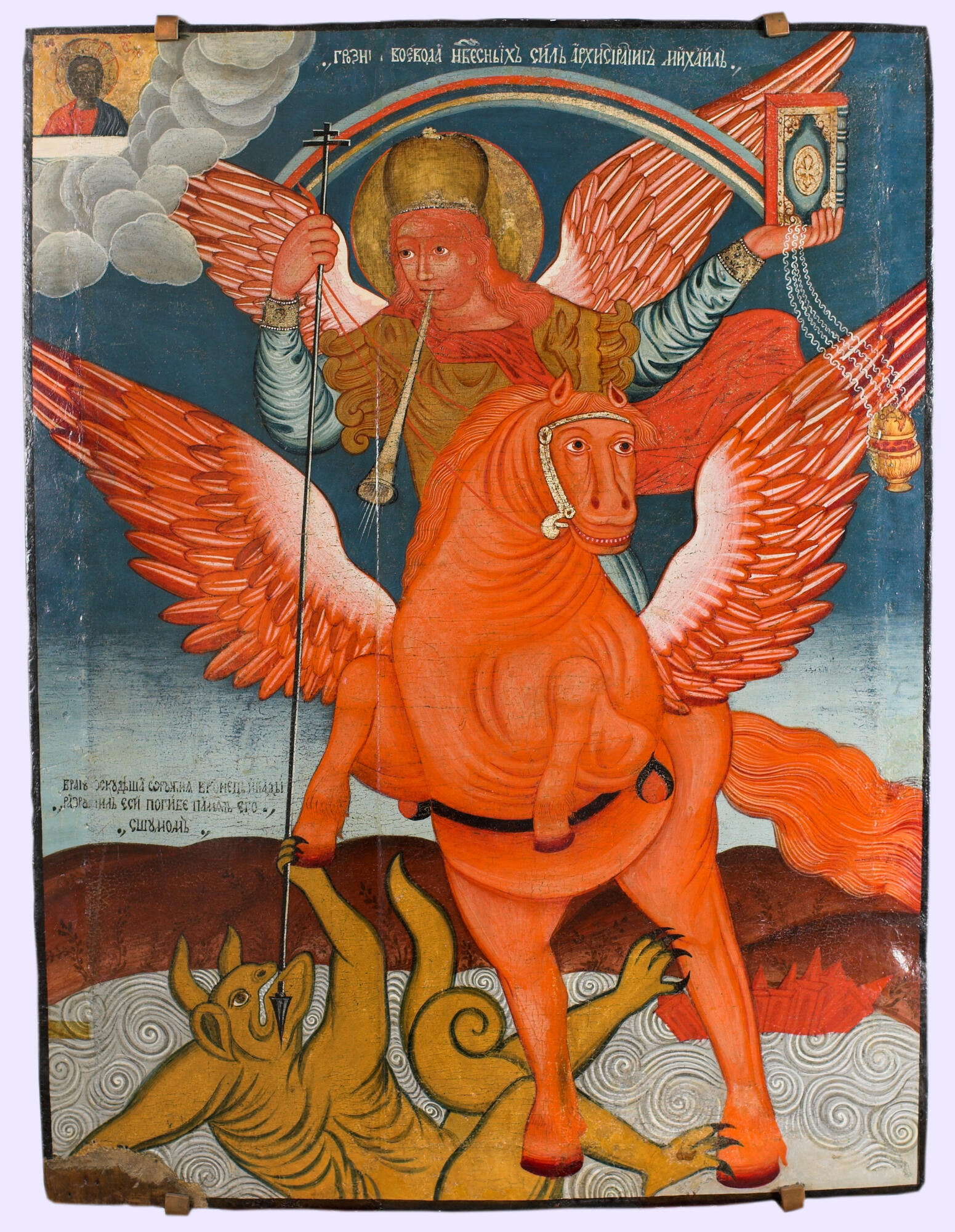Archangel Michael is the senior Archangel, head of the host of angels and archangels. In the book of Daniel, he is mentioned as a great Prince who stands for the people of the Lord. He is considered to be the heavenly protector of the Russian army.
Icons with the Archangel Michael can often be seen in Siberia, the Urals, and in the Volga region. The St.John’s Revelation says that the Archangel Michael defeated Satan. In the central part of the icon — the centerpiece — this story is depicted. A fire-faced horse-rider on a fiery winged horse strikes the Satan in the mouth. A horned monster with clawed feet is defeated under the hooves of a horse against the background of a swirling water stream. There is a trumpet in the Archangel Michael’s mouth. In his right hand he is holding a spear, with the cross on the shaft of the spear, in his left hand he is holding the Gospel with a four-pointed cross on the lid and a censer.
In the right part of the icon, there is a city sinking in the water and dying. Above it there is a brown strip — ’pozyom’, in iconography it is a conditional image of the earth. And in the upper part of the icon there is the sky painted using the shading technique from pale blue to dark blue. This technique is often found in the icons painted in the Yenisey region. In the upper corner, the icon painter depicted Christ before the throne. His face is surrounded by swirling gray clouds.
The composition of this icon has a special feature. According to the Orthodox iconography rules, the horse is usually painted side-face, and the rider is painted full-face. Here we see that both the Archangel Michael and his faithful fiery companion are turned face and torso to the viewer.
At the top of the background there is an inscription: ‘Severe warchief of the Heavenly Host Archangel Michael.’ To the left, against the sky, there is an inscription from Psalm 9:7: ‘O thou enemy, destructions are come to a perpetual end: and thou hast destroyed cities; their memorial is perished with them.’ The full translation of this text sounds like this: ‘According to Thy will boil the sea, the enemy has no weapons at all, and thou hast destroyed cities, their memorial is perished with them.’
The edges of the icon were covered with brass frame of wrought silver — embossed pattern. When this ancient artwork was restored in 2001, it turned out that this wrought silver strip wasn’t almost preserved, and it was decided not to restore it. Instead of the Christ’s nimbus and the nimbus above the head of the Archangel there were raised removable crowns. Today both of them are lost.
Icons with the Archangel Michael can often be seen in Siberia, the Urals, and in the Volga region. The St.John’s Revelation says that the Archangel Michael defeated Satan. In the central part of the icon — the centerpiece — this story is depicted. A fire-faced horse-rider on a fiery winged horse strikes the Satan in the mouth. A horned monster with clawed feet is defeated under the hooves of a horse against the background of a swirling water stream. There is a trumpet in the Archangel Michael’s mouth. In his right hand he is holding a spear, with the cross on the shaft of the spear, in his left hand he is holding the Gospel with a four-pointed cross on the lid and a censer.
In the right part of the icon, there is a city sinking in the water and dying. Above it there is a brown strip — ’pozyom’, in iconography it is a conditional image of the earth. And in the upper part of the icon there is the sky painted using the shading technique from pale blue to dark blue. This technique is often found in the icons painted in the Yenisey region. In the upper corner, the icon painter depicted Christ before the throne. His face is surrounded by swirling gray clouds.
The composition of this icon has a special feature. According to the Orthodox iconography rules, the horse is usually painted side-face, and the rider is painted full-face. Here we see that both the Archangel Michael and his faithful fiery companion are turned face and torso to the viewer.
At the top of the background there is an inscription: ‘Severe warchief of the Heavenly Host Archangel Michael.’ To the left, against the sky, there is an inscription from Psalm 9:7: ‘O thou enemy, destructions are come to a perpetual end: and thou hast destroyed cities; their memorial is perished with them.’ The full translation of this text sounds like this: ‘According to Thy will boil the sea, the enemy has no weapons at all, and thou hast destroyed cities, their memorial is perished with them.’
The edges of the icon were covered with brass frame of wrought silver — embossed pattern. When this ancient artwork was restored in 2001, it turned out that this wrought silver strip wasn’t almost preserved, and it was decided not to restore it. Instead of the Christ’s nimbus and the nimbus above the head of the Archangel there were raised removable crowns. Today both of them are lost.



